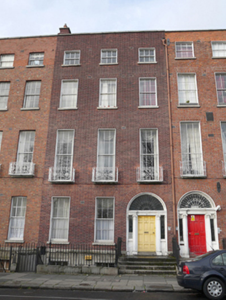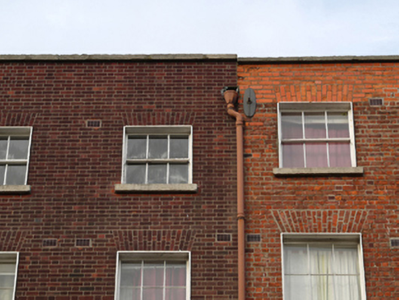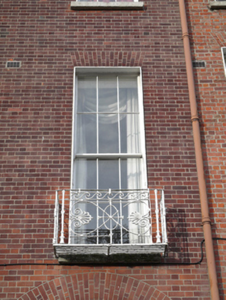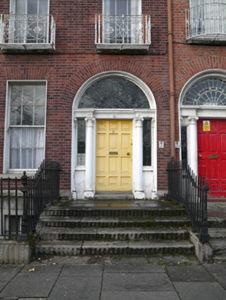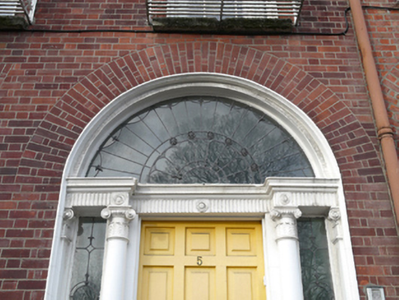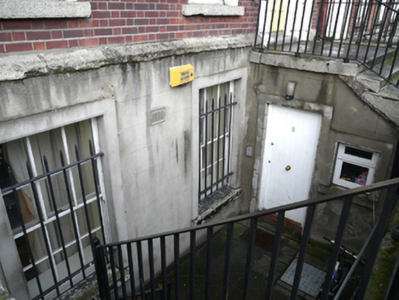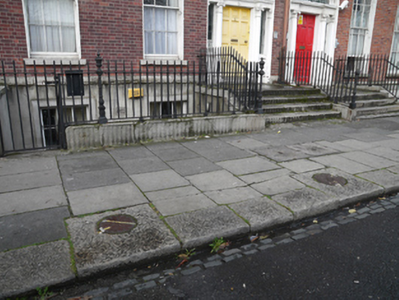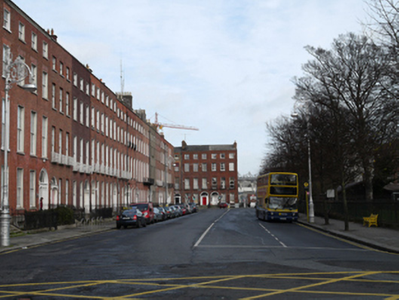Survey Data
Reg No
50010818
Rating
Regional
Categories of Special Interest
Architectural, Artistic
Original Use
House
Historical Use
School
In Use As
Apartment/flat (converted)
Date
1790 - 1795
Coordinates
315994, 235503
Date Recorded
08/12/2011
Date Updated
--/--/--
Description
Terraced three-bay four-storey house over raised basement, built c.1792, having full-height bow to rear (north)elevation. Now in multiple occupancy. Double-pile slate roof, hipped to east to front (south) with two hipped projections set perpendicular to rear and red brick chimneystack having clay pots to west party wall, hidden behind red brick parapet wall with granite coping. Octagonal cast-iron hopper and downpipe to east side of front elevation. Replacement red brick wall laid in Flemish bond with flush pointing to moulded granite plinth course over ruled-and-lined rendered wall to basement. Gauged brick flat-arch window openings with patent rendered reveals, granite sills and replacement timber sliding sash windows, six-over-six pane to lower floors and three-over-three pane to top floor. Cast-iron balconettes to first floor windows. Render architraves and steel grilles to window openings to basement. Gauged brick round-arched door opening having rendered reveal and painted stone Ionic doorcase, with replacement timber panelled door flanked by engaged Ionic columns, leaded sidelights and quarter engaged responding Ionic pilasters supporting fluted stepped lintel cornice and replacement fanlight. Door opens onto granite platform with cast-iron bootscraper and four fluted granite steps bridging basement. Platform and basement enclosed by original wrought-iron railings and cast-iron corner posts set on fluted granite plinth wall to street with matching iron gate providing basement access. Steel steps having metal railings to basement. Square-headed door and window openings to wall under entrance platform. Pair of cast-iron coal hole covers set in granite flags to pavement to front.
Appraisal
This Georgian townhouse forms part of a terrace of eighteen on the north side of the square, numbers 5 and 6 being built by the plasterer, James McCullough. It retains much of its early character and is enlivened by an aesthetically-pleasing doorcase, with notable fluting to the steps and plinth wall. Cast-iron balustrades to the first floor add decorative interest, and granite detailing to the sills, coping and plinth course articulate the façade. This building forms an strong component part of the important urban landscape of Mountjoy Square. The setting is enhanced by the stone plinth, gate and railings to the basement area and by the flight of steps to the entrance. Mountjoy Square was built on lands formerly belonging to Saint Mary’s Abbey and laid out in 1790 by Luke Gardiner II, completed by 1818. Originally called Gardiner Square the plan was to develop a strong vista from Custom House to Mountjoy Square then on to the planned Royal Circus. Unlike other Georgian squares in the city, this example was more carefully laid out with a unified parapet height and the east-west approaches offset to create a sense of enclosure. After falling into serious neglect and dereliction throughout the twentieth century resulting in the loss of one third of its original buildings, the square has since been repaired.

